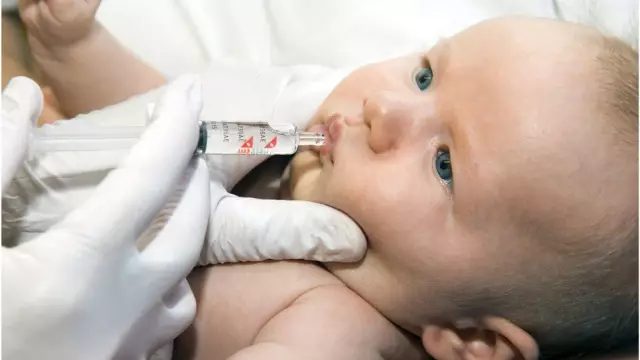- Author Curtis Blomfield [email protected].
- Public 2023-12-16 20:44.
- Last modified 2025-01-23 17:01.
Rotavirus infection is an intestinal disease that almost always affects children. Adults, due to the developed immunity and higher acidity of gastric juice, if they get sick, they easily tolerate the infection. Children, especially of younger preschool age, often end up in the hospital because of this disease and cannot be discharged from it for a long time, since rotavirus, in addition, tends to worsen several times. That is why it is very important that a person diagnosed with a rotovirus infection receive correct and adequate treatment from the very beginning.

The disease develops 1-5 days after infection with the virus. It gets to a person mainly through dirty hands. How is rotovirus transmitted? A sick child or adult actively sheds the virus in saliva, feces,urine. Infection usually occurs when eating food from a common dish with a sick child, when children, without washing their hands and playing with the same toys with a sick baby, then go to eat. The virus spreads through water and milk. There are also cases of carriage of the infection by adults: a person remains he althy, and a rotovirus infection is transmitted from him to others. Treatment, of course, is not carried out, since the carrier does not know about his disease.
How does rotavirus infection manifest itself?
Usually, at first, catarrhal phenomena appear: runny nose, slight cough, sore throat. The rotovirus infection then shows the following symptoms:
- high temperature, which is very difficult to reduce with antipyretics;
- vomiting;
-diarrhea: the stool becomes liquid, frequent, the frequency of bowel movements can reach 20 or more times;
- nature of the stool: liquid, light brown or dark brown, frothy, with an unpleasant odor, usually no blood or mucus in it.

Rotavirus infection is very difficult for many children:
1) in some, the leading symptom is a high temperature, and in order to reduce it, it is necessary to use physical methods of cooling and a combination of various antipyretic drugs with antispasmodics (for example, Nurofen and No-shpa drugs in an age dosage);
2) for others, diarrhea and vomiting quickly lead to dehydration, and often the only way to replace fluid loss is with drips;
3) still others suffer from an acetonemic condition when to combatdisease, the body spends all the glucose, and to maintain life processes, it begins to utilize fat, as a result, ketone (acetone) bodies are formed that poison the central nervous system, causing indomitable vomiting and abdominal pain.
Rotovirus infection: treatment of uncomplicated forms
- Interferon preparations are used to fight the virus: for children, these are Laferon or Viferon preparations in suppositories at an age dosage; you can also use the tool "Lipoferon", which is taken orally.
- Sorbents: "Smekta" and "White Coal" - for young children, for older children - "White Coal", "Atoxil" or "Enterosgel" in age dosages.
- Drink more fluids.
- Diet in the acute period. Rice broth, rice porridge almost without s alt, not in meat broth, almost without oil, vegetarian soups, a small piece of banana, jelly from non-acidic berries, weak black tea with almost no sugar, crackers, biscuits. Dairy products, coffee, cocoa, cakes, sweets, fried, smoked, spicy foods - exclude.

Rotovirus infection: treatment of complications
Therapy of complications is carried out together with the main treatment: sorbents, the drug "Viferon" are given in the same volume. The diet is the same.
1. Treatment for dehydration. It is necessary to give the patient a drink, that is, give him the volume of liquid given to him per kilogram of weight (for example, in children weighing 10 kg - this is 1 liter of liquid) plus the liquid that the person has already lost with diarrhea andvomiting, plus the need to replace the water that the patient continues to lose.
You need to replenish the liquid with Oralit, Regidron or similar solutions, partially with tea or plain water. You need to give a tea-dessert spoon every 10-15 minutes.
If the patient does not retain fluid, or you notice that the volume of urine has decreased, go to the hospital, where this volume will be returned intravenously using droppers.
2. Treatment of the acetonemic condition consists in the introduction of solutions in the form of a sweetened drink and electrolyte solutions. The calculation of the replenished liquid is considered the same: the liquid needed to sustain life, plus the water already lost with feces, temperature, vomiting, plus the volume that is lost. Due to the fact that elevated levels of ketone bodies cause severe vomiting, it is often impossible to get a person drunk. Only IV fluids can help him.
If 6-8 hours have passed since the home treatment, and you see that the child is getting worse, do not take risks longer - go to the hospital. If we are talking about a baby, you should not wait at all - you need to call an ambulance right away.






